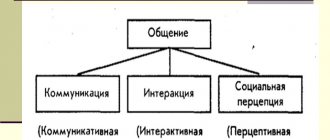Certain circumstances, misunderstandings, and a negative attitude towards the interlocutor lead to conflict.
This incident happens to everyone and it is a natural process that occurs in different life situations.
Experts highlight both the pros and cons of the conflict. There are many consequences to such incidents that you should be aware of.
You will find recommendations for correcting the hyperthymic type of character accentuation on our website.
Nature and reasons for its occurrence
Conflict arises when one side believes that the other is infringing on its interests.
When people have too different perceptions of what is happening , their opinions on a particular issue do not coincide, a clash occurs.
Each side tries to prove that it is right and rejects the opponent’s arguments. People stop hearing each other and become fixated only on their own point of view.
Respect for each other and tolerance disappear, hatred and contempt grow. is born to prove to the other side that you are right and to accept it.
Experts consider conflicts to be a natural phenomenon that arises during human socialization.
He tries to make friends, certain acquaintances appear. During communication, sometimes interlocutors realize that their opinions differ , and this gives rise to negative situations.
Conflicts are usually accompanied by disputes and aggression , but there are times when interlocutors come to a compromise and respect not only their own opinion, but also the opinion of their opponent.
Psychologists have identified several causes of conflict:
- Objective . Mismatch of interests, outlook on life. In this case, the parties cannot accept each other’s views and criticize.
- Organizational and managerial . Associated with a person’s professional activity, when an employee makes mistakes, feels pressure from a manager, or the boss does not carry out instructions, or is criticized by subordinates. Both sides are dissatisfied with each other, expectations do not correspond to reality.
- Socio-psychological . Usually this is an incorrect assessment of the results of activities, or the person treats an adult as a child and talks to him as if he were a little one, and does not give serious instructions.
- Personal . Mismatch of temperaments, characters, insufficient social adaptability, incorrect assessment of one’s own capabilities. Your own self-improvement will help prevent negative situations.
Such an incident can also be provoked by raising the voice, rude language, arrogance, lack of desire to talk, or solve the problem during communication.
Causes of conflicts:
Ways to resolve a conflict situation
Conflict management identifies several ways out of the current situation.
Device. Changing your own point of view, reforming your behavior, mitigating contradictions, even to the detriment of your own interests. Free or forced refusal of confrontation and surrender of one’s positions. One has to agree with this strategy for various reasons:
- the obligation to maintain good relations;
- understanding that you are wrong;
- strong dependence on the opponent;
- the frivolity of the problem;
- significant damage caused during the struggle;
- the threat of even more negative consequences;
- no chance of a different result;
- pressure from a third party.
Necessary and sufficient conditions and factors
Conflict conditions are circumstances that provoke the emergence of negative situations. They can be objective and subjective. Objective conditions include:
- changes in the economic, political and social life of society,
- financial stratification of citizens, when people’s incomes differ significantly,
- violation of traditional, moral principles,
- illnesses: both physical and psychological.
The subjective conditions for the birth of conflict are:
- the person is too anxious and excited,
- stressful state,
- selfish behavior
- low moral and personal qualities of a person,
- inability to build relationships with other people.
What is it: concept
The word “conflict” is translated from Latin as “collision” .
There are many types of conflicts, such as political, legal, economic, social.
Social conflict is a clash between two or more parties, caused by the presence of acute contradictions between them, such as a discrepancy in views, goals, and interests.
Social conflicts can have different scales: both individual people and social communities of different scales can act as parties to the conflict.
The most significant social conflicts can lead to paramilitary clashes, civil wars, and revolutions.
Structure, constructive and destructive functions
The conflict consists of the following elements:
- An object . They can be material, spiritual or social values. They vary depending on the situation.
- Participants . These are individuals, groups of people, organizations and even states. Not only individuals, but also huge groups can conflict.
- Conditions, social environment. The role is played by what social class the participants belong to, where they live, and what professional positions they hold.
- Subjective perception .
Each participant in the conflict will perceive the situation in his own way and respond to it with certain emotions and feelings. They can literally overwhelm one person, while another will perceive what is happening calmly, without emotion.
According to psychologists, conflicts perform constructive and destructive functions. Design features include :
- Identifying contradictions. Conflict can highlight unresolved issues that exist between people.
- Assessment of individual psychological characteristics of a person . The parties to the conflict discover previously unknown character traits of each other.
- Easing mental tension. You can get rid of irritability and relieve tension.
- Personal development. A person gains experience communicating with people, learns to build communications with other people, and find a common language.
- Improving the qualities of individual activity. People's activity accelerates, and skills for behavior in extreme situations are developed.
In other words, the constructive functions are positive. They perform positive functions that best influence a person’s personality, and conflict acts as a kind of development and gain of experience.
Destructive functions are different, they are negative and include:
- Violation of the communication system, a person faces difficulties in communicating with people.
- A person experiences negative emotions.
- Growing hostility towards the other side of the conflict.
- One conflict may be followed by another if the parties have not resolved the differences that have arisen.
Conflict has both positive and negative functions.
Both sides experience certain emotions and feelings during the conflict, so psychologists say that these incidents are experiences .
In one case it can be positive, and in another negative.
Conflicts: constructive or destructive, how to determine? Watch the video:
Consequences of social conflict
The consequences of the conflict are very contradictory.
On the one hand, conflicts destroy social structures and lead to significant unnecessary expenditure of resources, on the other hand, they are a mechanism that helps solve many problems, unites groups and ultimately serves as one of the ways to achieve social justice. The duality in people's assessment of the consequences of conflict has led to the fact that sociologists involved in conflict theory have not come to a common point of view on whether conflicts are useful or harmful for society.
The severity of the conflict depends to the greatest extent on the socio-psychological characteristics of the warring parties, as well as on the situation requiring immediate action. By absorbing energy from the outside, a conflict situation forces participants to act immediately, putting all their energy into the conflict.
The duality of people's assessment of the consequences of a conflict has led to the fact that sociologists involved in the theory of conflicts, or, as they also say, conflictology, have not come to a common point of view on whether conflicts are useful or harmful for society.
Thus, many believe that society and its individual components develop as a result of evolutionary changes, and as a result, they assume that social conflict can only be negative, destructive. But there is a group of scientists consisting of supporters of the dialectical method.
They recognize the constructive, useful content of any conflict, since as a result of conflicts new qualitative certainties appear.
Let us assume that in every conflict there are both disintegrative, destructive, and integrative, creative moments. Conflict can destroy social communities. In addition, internal conflict destroys group unity.
Speaking about the positive aspects of the conflict, it should be noted that a limited, private consequence of the conflict may be an increase in group interaction. Conflict may be the only way out of a tense situation.
Thus, there are two types of consequences of conflicts:
- disintegrated consequences that increase bitterness, lead to destruction and bloodshed, to intra-group tension, destroy normal channels of cooperation, and distract the attention of group members from pressing problems;
- integrative consequences that determine the way out of difficult situations, lead to the resolution of problems, strengthen group cohesion, lead to the formation of alliances with other groups, and lead the group to understand the interests of its members.
Let's take a closer look at these consequences:
Positive consequences of conflict
A positive, functionally useful result of a conflict is considered to be the solution to the problem that gave rise to disagreements and caused clashes, taking into account the mutual interests and goals of all parties, as well as achieving understanding and trust, strengthening partnerships and cooperation, overcoming conformity, humility, and the desire for advantage.
Socially (collectively) - the constructive influence of the conflict is expressed in the following consequences:
Conflict is a way of identifying and fixing disagreements
, as well as problems in society, organization, group. The conflict indicates that contradictions have already reached their highest limit, and therefore it is necessary to take immediate measures to eliminate them.
Thus, any conflict performs an informational function
, i.e. provides additional impulses to understand one’s own and others’ interests in the confrontation.
Conflict is a form of resolving contradictions
. Its development helps eliminate those shortcomings and miscalculations in social organization that led to its emergence. Conflict helps to relieve social tension and eliminate a stressful situation, helps to “let off steam” and defuse the situation.
Conflict can perform an integrative, unifying function
. In the face of an external threat, the group uses all its resources to unite and confront the external enemy. In addition, it is the task of solving existing problems that unites people. In search of a way out of the conflict, mutual understanding and a sense of involvement in solving a common task occurs.
Resolving the conflict helps to stabilize the social system, since it eliminates sources of discontent. The parties to the conflict, trained by “bitter experience,” will be more cooperative in the future than before the conflict.
In addition, conflict resolution can prevent the occurrence of more serious conflicts.
that might have arisen if this had not happened.
Conflict intensifies and stimulates group creativity
, contributes to the mobilization of energy to solve problems assigned to subjects. In the process of searching for ways to resolve the conflict, mental forces are activated to analyze difficult situations, new approaches, ideas, innovative technologies, etc. are developed.
Conflict can serve as a means of clarifying the balance of power of social groups or communities
and thus can warn against further, more destructive conflicts.
Conflict can become a source of new communication norms
between people or help fill old norms with new content.
The constructive impact of conflict at the personal level reflects the impact of conflict on individual traits:
- the fulfillment of a cognitive function by a conflict in relation to the people who take part in it. In difficult critical (existential) situations, the real character, true values and motives of people’s behavior are revealed. The ability to diagnose the enemy’s strength is also related to the cognitive function;
- promoting self-knowledge and adequate self-esteem of the individual. Conflict can help to correctly assess one’s strengths and abilities, and to identify new, previously unknown aspects of a person’s character. It can also strengthen character, contribute to the emergence of new virtues (a sense of pride, self-esteem, etc.);
- removal of undesirable character traits (feelings of inferiority, humility, pliability);
- increasing the level of socialization of a person, his development as an individual. In a conflict, an individual in a relatively short period of time can gain as much life experience as he may never receive in everyday life;
- facilitating the employee’s adaptation to the team, since it is during conflict that people reveal themselves to a greater extent. The person is either accepted by the group members, or, conversely, they ignore it. In the latter case, of course, no adaptation occurs;
- reducing mental tension in the group, relieving stress among its members (in case of a positive resolution of the conflict);
- satisfaction of not only primary, but also secondary needs of the individual, his self-realization and self-affirmation.
Negative consequences of conflict
The negative, dysfunctional consequences of the conflict include people’s dissatisfaction with the common cause, a retreat from solving pressing problems, an increase in hostility in interpersonal and intergroup relations, a weakening of team cohesion, etc.
The social destructive impact of conflict manifests itself at various levels of the social system and is expressed in specific consequences.
When resolving a conflict, violent methods may be used, which may result in large casualties and material losses. In addition to the direct participants, those around them may also suffer in the conflict.
Conflict can lead the opposing parties (society, social group, individual) into a state of destabilization and disorganization. Conflict can lead to a slowdown in the pace of social, economic, political and spiritual development of society. Moreover, it can cause stagnation and a crisis of social development, the emergence of dictatorial and totalitarian regimes.
Conflict can contribute to the disintegration of society, the destruction of social communications and the sociocultural alienation of social entities within the social system.
The conflict may be accompanied by an increase in pessimism and disregard for customs in society.
Conflict can cause new, more destructive conflicts.
Conflict often leads to a decrease in the level of organization of the system, a decrease in discipline and, as a consequence, a decrease in operational efficiency.
The destructive influence of conflict at the personal level is expressed in the following consequences:
- negative impact on the socio-psychological climate in the group: signs of a negative mental state appear (feelings of depression, pessimism and anxiety), leading a person to a state of stress;
- disappointment in one's capabilities and abilities, deintensification of the face; the emergence of a feeling of self-doubt, loss of previous motivation, destruction of existing value orientations and patterns of behavior. In the worst case, the consequence of the conflict can be disappointment, loss of faith in former ideals, which gives rise to deviant behavior and, as an extreme case, suicide;
- a person’s negative assessment of his partners in joint activities, disappointment in his colleagues and recent friends;
- a person’s reaction to conflict through defense mechanisms, which manifest themselves in various forms of bad behavior:
- indentation - silence, separation of the individual from the group;
- information that frightens with criticism, abuse, demonstration of one’s superiority over other members of the group;
- solid formalism - formal politeness, establishing strict norms and principles of behavior in a group, observing others;
- turning everything into a joke;
- conversations on unrelated topics instead of business discussions of problems;
- constant search for those to blame, self-flagellation or blaming team members for all troubles.
These are the main consequences of the conflict, which are interconnected and are specific and relative in nature.
Source: https://posledstviya.ru/posledstviya-socialnogo-konflikta/
Positive and negative sides
These incidents can have both positive and negative sides.
Positive consequences
The positive consequences of these incidents are:
- Development of interactions both between individuals and between social groups.
- Such situations improve relationships. They move to a new level, people open up to each other.
- Conflicts reveal the advantages and disadvantages of certain relationships.
- With the help of such situations, more harmonious relationships can be built; individuals do not hide their real feelings.
- The participants in the situation get to know each other.
Thanks to such situations, people figure out whether they should continue to be friends or not, build relationships or not .
Relationships become more trusting and misunderstandings are eliminated.
Conflicts have a positive impact on society only if they occur rarely , do not torment people internally, and do not lead to stressful conditions.
Then people trust each other more, are more open and undisguised.
If they happen frequently, society becomes embittered, aggressive, cases of crime increase, and people cannot establish communication and are unable to build relationships.
Compromise
Compromise is a partial satisfaction of the interests of all subjects of conflict interaction.
Basic human actions with the “Compromise” strategy
- Focus on equality of positions
- Offering your own options in response to your opponent’s offer of options
- Sometimes using cunning or flattery to gain favor from an opponent
- Striving to find a mutually beneficial solution
Pros and cons of the “Compromise” strategy
Despite the fact that compromise implies satisfaction of the interests of all subjects of conflict interaction, which, in fact, is fair, it is important to keep in mind that in most situations this strategy should be considered only as an intermediate stage in resolving the situation, preceding the search for the most optimal solution, completely satisfactory to the conflicting parties.
5
Family as one of the small groups where conflict situations periodically occur
Family conflicts are among the most common. According to statistics, almost every family member has to deal with misunderstanding from one of their close relatives. The reasons for the development of conflicts in this group of individuals are:
- Strong differences in character and temperament both among spouses and among children and relatives.
- Everyday problems. In most cases, a conflict situation arises among couples precisely because of a lack of funds.
- Unjustified expectations. The clash arises due to unjustified hopes placed on the marriage by one of the spouses.
- Dissatisfaction with sex life.
- Treason. Due to dissatisfaction with sex, often one of the spouses (less often both) begins to look for warmth and affection on the side. The result is the development of a conflict situation leading to a rupture. However, some try to add “spiciness” to relationships, thereby saving them.
- Lack of personal space. Most couples constantly spend time together without having the opportunity to be alone, which leads to the “conquest” of certain areas of the house.
- Jealousy, heightened sense of ownership. Some types of people tend to overprotect their partner, limiting their communication with the opposite sex, while constantly suspecting their spouse of non-existent infidelity. An example of a conflict, the development of which is due to jealousy: one of the spouses constantly read the personal correspondence of his partner, but when the latter saw this, a scandal broke out.
- Abuse of alcohol and drugs by one of the partners, smoking.
- Different views on the educational process. If there are children in the family, then conflict can often arise due to dissatisfaction of one of the parents with the other about their upbringing.
Signs
Main signs of conflict:
- the presence of circumstances that the parties consider to be conflicting,
- the presence of inconsistency, contradictions in the views, goals, interests of the parties,
- conflict interaction between participants,
- the use of various methods of pressure on opponents (including physical and mental violence),
- results of conflict interaction.
As a rule, conflict situations do not exclusively benefit the parties, and much depends on the specific conflict and the individual characteristics of the participants.
It is also important to consider that each of the participants and observers is able to assess the conflict and its outcome differently.
Characters
Conflict participants are parties directly involved in the formation and completion of a conflict of interests. There are 2 types of actors: indirect and direct participants in the conflict.
Indirect ones include:
- Provocateur. A person (state, group, society) who provokes another person into a conflict, while in some cases not taking part in the conflict situation itself.
- The provocateur's ally, or "support group." A person who contributes (materially, morally) to the development of a collision.
- Organizer (creator) of the conflict.
- Judge (mediator, intermediary). A person who is a third party in a conflict situation.
Direct ones include:
- The instigator. Sometimes it is a provocateur.
- Subject.
- Sides of the collision.









